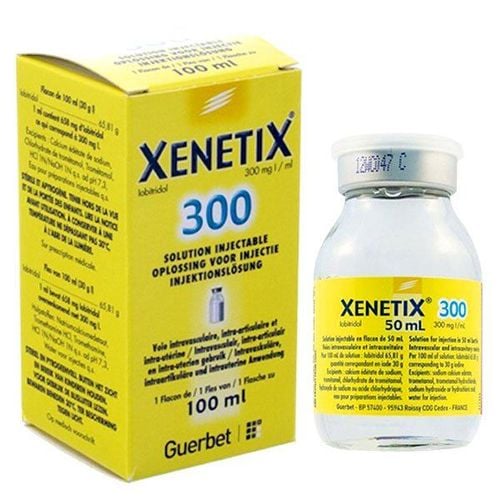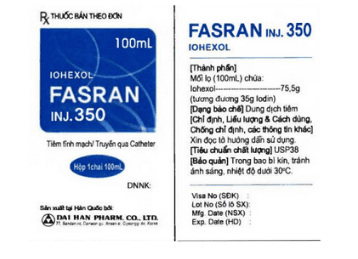This is an automatically translated article.
Ultravist, a contrast agent used in laboratory techniques. The drug has many different strengths such as Ultravist 150, Ultravist 240, Ultravist 300 and Ultravist 370. Ultravist can be used for both adults and children but not for pregnant women.
1. What is Ultravist?
Ultravist is a contrast agent used in laboratory techniques to aid in the diagnosis of physical disease.
The drug contains the main ingredient Iopromide with many different strengths. This is an iodinated contrast agent that helps mechanical systems to accurately record images of body parts on X-ray or CT films... Based on that image, Doctors and other professionals can assess the health status as well as abnormalities occurring in the designated areas of the body to be taken, assist in the diagnosis of the disease and give the appropriate treatment plan. .
Iopromide is a drug used in:
Intra-arterial injection during DSA angiography procedures. Patients should be checked for shunt function during dialysis. CT scan. Intravenous urography. Venous angiography of the extremities. Take pictures of body cavities such as uterus, fallopian tubes, fistulas or X-rays of the knee joint with contrast. Note that the drug should not be used in the indications of spinal, ventricular or sinuses containing fluid. The drug should not be used in patients with hyperthyroidism and pregnant women.
2. Uses of Ultravist
Ultravist is indicated in the following cases:
CT scan. Angiography, intravenous DSA, and arterial DSA. Intravenous urology. Contraindications to use the drug with:
Patients with a history of allergy or hypersensitivity to any of the ingredients of the drug. People with hyperthyroidism, have been or are being treated. Do not use the drug on pregnant women.
3. Dosage and how to use Ultravist
Ultravist is produced in the form of an infusion solution with many different strengths and packages:
Ultravist 150: 0.31g/ml injection solution, bottled 50ml. Ultravist 240: 0.5g/ml injection solution, bottles of 20ml, 50ml, 100ml and 20ml. Also available in 100ml ampoules or vials. Ultravist 300: 0.62g/ml injectable solution, in 20ml, 50ml, 75ml, 100ml, 150ml and 200ml bottles, plus 5ml ampoules or vials. Ultravist 370: 0.77g/ml injection solution, available in 100ml, 150ml and 200ml bottles, 30ml ampoules or vials. Dosage of the drug:
For patients requiring intravenous urography: Adults: 1ml injection. Children: calculate dose according to body weight, use 4ml/kg body weight. In young children use 1.5ml/kg body weight, and in infants use 3ml/kg. For CT scan of brain: inject 1ml, maximum use 2ml/kg body weight. Intravenous DSA: 30 to 60ml. Note: The dose in angiography may vary depending on the patient's age, weight, physical condition, clinical symptoms, cardiac output, and imaging technique. When DSA is taken through an artery, the dose will be lower than when it is taken through a vein.
4. Side effects and notes when using Ultravist
The most common side effects when using Ultravist are nausea, vomiting, heat and pain, and rash.
Some other possible side effects related to the Iopromide component in the drug:
Circulatory reactions accompanied by signs of hypotension due to peripheral vasodilation. Tachycardia, patients with shortness of breath, increased excitability, cyanosis, confusion, severe may lose consciousness. If a patient has any of the above symptoms, it is important to seek emergency care as soon as possible. To be safe for patients, when using Ultravist, it is important to note the following:
Use the drug when absolutely necessary. Use the drug strictly according to the instructions prescribed by the specialist, do not arbitrarily change the dose increase or decrease without the prescription of the doctor or people with medical expertise. Be especially careful if the patient has a history of hypersensitivity to contrast agents containing iodine. Use with caution:
Patients with liver failure, kidney failure, heart failure, circulatory failure. Cerebral vascular atherosclerosis. The patient had a convulsion of brain origin. People with emphysema, diabetes, hyperthyroidism, mild goiter or multiple myeloma also need to be careful when using the drug. The drug is produced in the form of intravenous injection, absolutely not for oral, intramuscular or other drug routes. Do not use the drug on pregnant women. The drug can cause hypotension, changes in heart rate, vomiting... Therefore, caution should be exercised in patients who need to drive or are involved in operating machinery. It is best to let the patient rest until the body is completely stabilized before being allowed to return to work. This is an adjunct in subclinical procedures to serve the diagnosis, not a medicine to treat the disease. The drug is only used in specialized hospitals or clinics, not for external use without a doctor's prescription. Store medications according to the manufacturer's instructions. Do not use expired medicine to inject the patient. Keep medicine out of reach of children. Angiography or X-ray with contrast is one of the very necessary techniques in supporting clinical diagnosis. However, not every patient or any disease requires contrast-enhanced imaging. Whether the scan requires the use of contrast agents or not depends on many factors such as the patient's health status, clinical symptoms, diagnostic orientation of specialists... Contrast in general, Ultravist in particular also has certain dosages and side effects. Please consult your doctor for specific advice on your health condition as well as appropriate diagnostic support methods.













